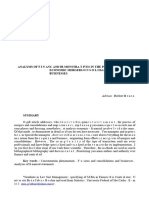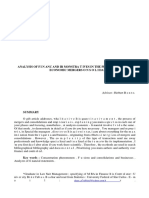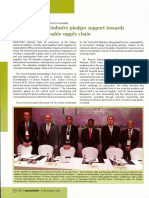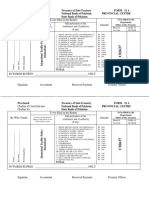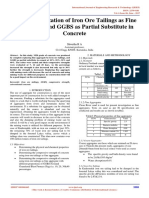Cooperative Farmingwill It Augment Marketable Surplus
Cooperative Farmingwill It Augment Marketable Surplus
Uploaded by
mayankagawal26Copyright:
Available Formats
Cooperative Farmingwill It Augment Marketable Surplus
Cooperative Farmingwill It Augment Marketable Surplus
Uploaded by
mayankagawal26Original Description:
Copyright
Available Formats
Share this document
Did you find this document useful?
Is this content inappropriate?
Copyright:
Available Formats
Cooperative Farmingwill It Augment Marketable Surplus
Cooperative Farmingwill It Augment Marketable Surplus
Uploaded by
mayankagawal26Copyright:
Available Formats
THE Nagpur Resol ut i on on co
operat i ve f a r mi ng i s bei ng
debated in a manner whi c h is
l i kel y t o i nhi bi t a dispassionate
consi derat i on of several issues,
bot h concept ual and operat i onal ,
i nvol ved i n i t . An emot i onal l y sur-
charged at mosphere wi l l pr obabl y
be requi red f or t he I mpl ement at i on
of a pr ogr amme of agr ar i an re-
const r uct i on as r adi cal as t he one
adumbr at ed i n t he Nagpur Resolu
t l on. Bu t t ha t does not mean t hat
persons on wh o m l ess t he responsi
bi l i t y f or t he i mpl ement at i on of
the pr ogr amme can af f or d t o r emai n
bl i ssf ul l y unconcerned about t he
knot t y issues wi t h whi ch t he pr o-
bl em bri st l es.
People's Participation
I nci dent al l y, t hi s raises t he ver y
fi rst issue as t o who exact l y wi l l
be ent rust ed wi t h t he i mpl ement a-
t i on of t he pr ogr amme. To say
t hat such a pr ogr amme cannot be
i mpl ement ed wi t hout "t he act i ve
par t i ci pat i on of t he people" i s not
very enl i ght eni ng and may even be
a sympt om of i nt el l ect ual e mpt i -
ness. It i s obvi ous t hat a pr ogr amme
l i ke t hi s cannot be i mpl ement ed
excl usi vel y by t he depar t ment al
agencies of t he Government . The ex-
perience of non-communi st count ri es
wi t h a record of successful i mpl e-
ment at i on of l and reforms e g.
Japan also indicates t he cr uci al
i mpor t ance of regi onal and l ocal
or gani sat i ons such as vi l l age c om-
mi t t ees.
I f , as i s post ul at ed i n t he Resol u-
t i on, the Panchayat s I n I ndi a are
t o pl ay t hi s cr uci al role, t he
colossal t ask of equi ppi ng t hem
wi t h t he requi si t e t echni cal and
or gani zat i onal know- how woul d
need t o be t ackl ed. Such r adi cal
measures have also been success-
f ul l y' i mpl ement ed i n the c o mmu -
ni st count ri es. ( Al l t hat i s i mpl i ed
I n cal l i ng t hem ' successful' i s t ha t
t he or gani zat i onal change was
effected.) I n these countries, t he
ma i n rel i ance was on Communi s t
Pa r t y cadres. I t i s for our consi-
der at i on whet her we, i n I ndi a,
woul d l i ke t o use t he i ns t r ument of
pa r t y cadres f or t hi s purpose,
t a k i n g i nt o consi derat i on a l l i t s
pol i t i cal i mpl i cat i ons. As i t is,
even the par t y i n power cannot
cl ai m t o have i n readiness such a
wel l - t r ai ned cadre of pol i t i cal
wor ker s wi t h t he necessary ideo
l ogi cal convi ct i on and or gani zat i onal
di sci pl i ne.
'Firm and Plant Approach'
The second poi nt to whi ch I
woul d l i ke t o refer i s t hat of
defi ni t i on and concept of co-opera
t i ve f a r mi ng. The Nagpur Resol u-
t i on defi ni t el y postulates "pool i ng
of l and f or j oi nt cul t i vat i on" .
Presumabl y, what i s i mpl i ed by
' pool i ng and j oi nt cul t i vat i on' i s the
mer gi ng of al l l and t o const i t ut e
one single f a r m. At a Semi nar on
Co-operat i ve Fa r mi ng, organi sed
by t he I ndi a n Society of Ag r i c u l -
t ur a l Economi cs, t hi s question was
ver y t hought f ul l y discussed. Pr o-
fessor D R Gadgl l , wi t h his usual
i nci si ve logic, contended t hat
pool i ng of l and and j oi nt cul t i vat i on
is a mat t er of secondary decision.
He recommended wha t may be
called, a ' Fi r m and Pl ant Appr oach' .
Thi s woul d i mpl y t hat al l i mpor t ant
decisions woul d be t aken by the
firm, i e, the general body of the
co-operat i ve. Thi s body woul d
have the freedom and t he aut hor i t y
t o det ermi ne, among ot her t hi ngs,
the farm-size pat t er n. I t may
decide t o pool al l t he l and or may
prefer t o ar r ange i t i n separate
bl ocks as Indi cat ed by agr onomi c
condi t i ons.
Whet her t he cul t i vat i on i s j oi nt
or not , the i mpor t ant poi nt i s t hat
co-operat i ve f a r mi ng woul d i mpl y
t r ansf er of decision ma k i n g aut ho-
r i t y ( r i ght ) i n r egar d t o al l i mpor t ant
mat t er s f r o m the i ndi vi dual t o the
col l ect i ve body of al l cul t i vat or s.
The degree of aut onomy whi ch i s
per mi t t ed by the co-operative ( f i r m)
t o i t s const i t uent uni t s ( f a r ms /
pl ant s) is a quest i on of pr agmat i c
decision and need not be deter
mi ned i n advance on a p r i o r i ideo-
l ogi cal grounds. Pool i ng of l and
and j oi nt cul t i vat i on need not , so
t o say, be wr i t t e n i n t he const i t ut i on
of t he co-operat i ve. One si gni f i cant
advant age of such a modi f i cat i on
woul d be t o make t he conf l i ct i ng
vi ews about t he economies of scale
319
I r r el evant i n deci di ng on the mer i t s
Of co-operat i ve f ar mi ng. The co-
operat i ve woul d be free to adopt
i nt ensi ve f ar mi ng, i f such a pat t er n
appeared to be advant ageous.
Small or Large Farms?
The mer i t of an agr ar i an pat t er n
can be j udged onl y i n t erms of the
objective it seeks to serve. Br oadl y,
these objectives are st at ed to be
economic efficiency and social
j ust i ce. Whi c h of these t wo, or
how much of each, the co operat i ve
j oi nt f a r mi ng wi l l serve, needs t o
be exami ned. The economic efficien
cy of agr i cul t ur e can be j udged by
pr oduct i vi t y and mar ket abl e surplus.
Since the Resol ut i on suggests t hat
l and wi l l be pooled f or j oi nt
cul t i vat i on, i t woul d appear t hat the
expect at i on i s t hat co-operat i ve
f a r mi ng wi l l help i n securi ng the
economies of scale. Dur i ng the
debate on the Resol ut i on, several
speakers had ment i oned t hat I ndi an
agr i cul t ur e suffered f r om the exis
tence of too many t i ny and scat
t ered hol di ngs and t hat one coul d
not expect i mpr ovement i n produc-
t i on under such ci rcumst ances. A
poi nt whi ch needs emphasis here is
the di st i nct i on between the per-
acre product i on and pr oduct i vi t y
i n t he i nput - out put sense. In so
far as product i on per acre is con-
cerned, i t i s not at al l proved t hat
smal l f ar ms are i nf er i or . The dat a
avai l abl e f r om t he f a r m manage-
ment surveys, whi ch were recent l y
conducted under t he R P C , i ndi cat e
t hat for food crops, at any rat e,
the per acre yi el d on t he smal l
f a r m i s l ar ger t ha n t hat on the
bi gger farms.
Thi s is t he posi t i on under the
present set up. It i s wel l - known
t hat s mal l f ar mer s suffer f r om
many handi caps i n t he mat t er of
supply of credi t as wel l as supply
of seeds, manure, etc. Some of
these coul d be overcome t hr ough
service co-operat i ves, wi t hout neces-
s ar i l y any change in the size of
t he uni t . I n compar i ng the rel at i ve
mer i t s of the smal l and the l arge-
sized farms, or i ndi vi dual and co-
operat i ve f ar mi ng, It i s but f ai r t o
assume t he existence of the same
favourabl e (or unf avour abl e) si t ua-
Co-operative Farmi ng
Wi l l It Augment Marketable Surplus ?
M L Dantwala
February 28, 1959
t i on i n r egar d t o anci l l ar y services.
On t he whol e, i t woul d t herefore
appear t hat i n t he mat t er of yi el d
per acre, at any rat e, t he l ar ger
f ar ms do not have any definite
advant age. Here is one more
reason why, as suggested earlier,
it is not necessary to decide in
advance t hat co-operative f a r mi ng
woul d necessarily i mpl y pool i ng of
l and f or purposes of Joint cul t i va-
t i on. A decision i n t hi s mat t er
ma y be left t o t he panchayat or
t he co-operative whi ch wi l l decide
i n the l i ght of t he condi t i ons i n
t hei r own vi l l age.
Man - Land Ratio
As for pr oduct i vi t y whi ch woul d
det ermi ne the r et ur n (i ncome) t o
l abour, t hi s woul d depend ma i nl y on
the man- l and r at i o as i t woul d
emerge aft er pool i ng of al l the
resources. I f , al ong wi t h the
pool i ng of l and, al l the exi st i ng
cul t i vat or s and a few mor e of l and-
less l abourers are accommodat ed
on t he co-operat i ve f ar m, there
wi l l be no i mpr ovement - and t here
ma y be even some det er i or at i on
- ' i n the new man- l and r at i o, and
t hi s wi l l have a depressing effect
on t he r et ur n whi c h wor ker s on
the co-operative f a r m wi l l re-
ceive. I n t hi s connect i on, i t i s
ar gued t hat doi ng a wa y wi t h i ndi -
vi dual owner shi p and pool i ng of
a l l resources woul d open up possi-
bi l i t i es of under t aki ng develop-
ment al act i vi t y such as soil
conservat i on, l evel l i ng, bundi ng,
l ayout of fi el d channel s etc whi ch
has t o cont end agai nst numerous
obstacles under t he exi s t i ng si t ua-
t i on, and t hereby enl arge t he scope
f or product i ve empl oyment wi t h i n
the agr i cul t ur al sector i t sel f.
Fur t her , co-operat i ve f a r mi ng
wi l l f aci l i t at e the release of surplus
l abour of i ndi vi dual f ar mer s who,
under the exi st i ng condi t i ons, are
t i ed down t o t hei r smal l uni t s ; and
t hough unempl oyed over consi dera-
ble periods, are oft en not avai l abl e
f or al t er nat e empl oyment . Thus,
co-operat i ve f a r mi ng opens up, on
the one hand, opport uni t i es f or
devel opment al wor k i n agr i cul t ur e,
and, on the other, also makes t he
disguised surplus l abour avai l abl e
for al t er nat e empl oyment . I t shoul d
however be cl earl y recognised t hat ,
even wi t h t he addi t i on of develop-
ment al act i vi t i es, i f a large number
of landless l abourers are accom-
modat ed on t he co-operat i ve f ar m,
the average Income of the members
may be less, t hough mor e equal ,
t ha n t hat of t he i ndi vi dual f ar mer s
at present. I f , on t he ot her hand,
the co-operative f a r m woul d i nsi st ,
as i t may, on t a k i n g up onl y an
opt i mum quant um of l abour force,
i t wi l l be mer el y conver t i ng t he
disguised unempl oyment i nt o open
unempl oyment and t r ans f er r i ng t he
responsi bi l i t y of i t s gai nf ul absorp-
t i on on some one else.
Mobilising the Surplus
Anot her i mpor t ant obj ect i ve whi ch
t he pl anners woul d l i ke t o achieve
t hr ough co-operat i ve f a r mi ng i s
mobi l i zat i on of surpl us bot h f or
the purposes of r ei nvest ment
( capi t al f or mat i on) and f or ma i n-
t a i ni ng an adequate supply f or
ur ban consumpt i on. The i mpor -
tance of reasonabl y stable prices
of foodgrai ns t o t he developmen-
t a l effort s of t he count r y i s uni ver -
sal l y recognised, and success i n
t hi s fi el d wi l l depend as much on
t he avai l abi l i t y of mar ket abl e
surpl us as on pr oduct i on. I t woul d
t herefore be pert i nent to enqui re
whet her co-operative f a r mi ng as a
f or m of pr oduct i on woul d be a mor e
sui t abl e i nst r ument f or mobi l i za-
t i on of t he surplus. Ot her t hi ngs
bei ng equal, i t i s obvi ous t ha t purel y
f r om t he poi nt of vi ew of admi ni s-
t r at i ve ar r angement , i t wi l l be
easier t o collect t he surplus f r om
t he fewer, organi sed uni t s of pr o-
duct i on such as a co-operative
f a r m t ha n i t woul d be i f i t were t o
be collected f r om a l arge number of
s mal l and scat t ered f ar ms. I n fact ,
one of t he ma i n at t r act i ons of t he
co-operative (col l ect i ve) f a r mi ng
st r uct ur e i n t he communi st coun-
t ri es was t hi s f aci l i t y f or mobi l i -
zat i on of t he surpl us whi c h t hi s
t ype of or gani sat i on offers.
The Machi ne Tr act or St at i ons
whi ch were, so t o say, the com-
muni s t versi on of service co-opera-
tives, per f or med t hi s f unct i on. Bu t
i t shoul d be emphasised t ha t t hi s
advant age coul d accrue ma i nl y
because (a) payment s f or services
rendered by t he MTS were pr i or
charge on t he produce, and ( b)
of t he syst em of compul sor y del i -
veries of produce of r el at i vel y l ow
prices. In the absence of these
t wo coercive devices, i t i s doubt f ul
whet her t he co-operative f ar ms i n
I ndi a woul d f aci l i t at e mobi l i zat i on
of surplus.
Higher Retention Probable
I t i s even probabl e t ha t t he out -
come ma y be cur t ai l ment of t he
330
surpl us. The concern wi t h soci al
j ust i ce and t he obj ect i ve of i mpr ov-
i ng the l i v i n g st andar d of t he c ul t i -
vat ors, associated wi t h t he proposal ,
woul d i mp l y hi gher r ur a l consump-
t i on t han at present a nd correspond-
i ngl y smal l er mar ket abl e surpl us.
Thi s woul d be par t i cul ar l y so, i f ,
by accommodat i ng t he landless
l abourers and ot her under-empl oyed
persons i n the vi l l age on t he co-
operat i ve f a r m, t he st at e i mpl i ci t l y
under wr i t es adequate subsistence
t o t he ent i r e f a r mi ng popul at i on,
i rrespect i ve of whet her ' or not
enough pr oduct i ve empl oyment i s
avai l abl e on t he f a r m.
At present, even a subsistence
f a r m, t o t he ext ent of i t s +requi re-
ment f or cash, has to release a
por t i on of i t s produce f or t he
mar ket . The par t i ci pant s on t he
co-operat i ve f a r m, however, woul d
be f ul l y j ust i f i ed i n t hei r cl ai m t o
r et ai n as much of t he produce of
the f a r m as woul d be needed for
ma i nt a i ni ng an i mpr oved st andar d
of l i vi ng. An d unl i ke t he com-
muni st state, t he Gover nment here
wi l l not , and must not, dare t o
collect any t h i n g f r om t he co-
operat i ve f ar ms , f or such an
at t empt woul d be made t o appear
as expl oi t at i ve and responsible f or
ma i nt a i ni ng a l ow level of l i v i n g of
t he agr i cul t ur i s t , or pr event i ng i t s
cont i nui ng I mpr ovement .
Under t he present syst em, taxes
apar t f r om rent and i nt erest -
are t he fi rst charge on the f ar mer ' s
produce. Under state-sponsored co-
operat i ve f ar mi ng, a decent level
of l i v i n g f or t he f a r me r woul d be
t he first charge. Whi l e such a
change woul d be desirable, i t woul d
not augment the mar ket abl e surpl us.
Programmes for Special Area'
FOR areas deser vi ng special t r eat -
ment and emphasis i ndi vi dual
pr ogr ammes of devel opment are
needed. No uni f or m pat t er n can he
equal l y effective i n t he whol e count r y.
There are probl ems pecul i ar t o
di fferent areas, e g, desert and dr y
areas, coast al areas, h i l l y areas, t r i -
bal areas, and areas ar ound ci t i es
and bi g t owns.
To hel p f or mul at i on of such i ndi -
vi dual pr ogr ammes t he Mi n i s t r y of
Communi t y Devel opment and Co-
operat i on has sent det ai l ed sugges-
t i ons t o the St at e Gover nment s.
Di f f er ent cont ent s of t he pr ogr amme
under vari ous devel opment al heads
sui t ed t o t he vari ous areas have been
suggested.
THE ECONOMIC WEEKLY
February 28, 1959
321
THE ECONOMIC WEEKLY
February 28, 1959
326
You might also like
- Savings Summary: We'Re Updating Our AtmsDocument2 pagesSavings Summary: We'Re Updating Our AtmsPavel Kolesnik33% (3)
- Module 8 & 9 Zairah AbilaDocument38 pagesModule 8 & 9 Zairah AbilaEfigenia Macadaan Fontillas80% (5)
- State, Market and Civil Society in The Era of GlobalisationDocument7 pagesState, Market and Civil Society in The Era of GlobalisationVishal Rollno 4004No ratings yet
- Kotval Mullin Fiscal ImpactDocument44 pagesKotval Mullin Fiscal ImpactMarkWeberNo ratings yet
- The Secret Form Ula For M Anaging M Ultiple Projects: Recent ResearchDocument2 pagesThe Secret Form Ula For M Anaging M Ultiple Projects: Recent ResearchAngel Castro MarceloNo ratings yet
- 2009 08 28 Sdwa Fs 30ann SWP WebDocument2 pages2009 08 28 Sdwa Fs 30ann SWP WebbendeniNo ratings yet
- Management Aspect: Type of Business OrganizationDocument12 pagesManagement Aspect: Type of Business OrganizationJc BuenaventuraNo ratings yet
- Livro 8 - TCC MBA - Convertido - InglêsDocument72 pagesLivro 8 - TCC MBA - Convertido - InglêsÁlaze BreviárioNo ratings yet
- Citizens' Pa Rticipa Tion: The Missing Link in Building Susta Ina Ble Cities? Lessons From Living City, Sa Ntia Go, ChileDocument20 pagesCitizens' Pa Rticipa Tion: The Missing Link in Building Susta Ina Ble Cities? Lessons From Living City, Sa Ntia Go, ChileLake SagarisNo ratings yet
- Contract Enforcement and Dispute ResolutionDocument3 pagesContract Enforcement and Dispute Resolutiona_gamalNo ratings yet
- Livro 8 - TCC MBA - Convertido - InglêsDocument72 pagesLivro 8 - TCC MBA - Convertido - InglêsÁlaze BreviárioNo ratings yet
- The Toyota Foundation Research Grant Program 2016 "Exploring New Values For Society" Project Proposal GuidelinesDocument18 pagesThe Toyota Foundation Research Grant Program 2016 "Exploring New Values For Society" Project Proposal GuidelinessteelyheadNo ratings yet
- M ThesisDocument110 pagesM ThesisfarhanamjadpkNo ratings yet
- Chemical Industry Paper3Document3 pagesChemical Industry Paper3HammadNo ratings yet
- Electric Utility Regulation: Procedures, Parameters and Current Issues From An In-Tervenor'S PerspectiveDocument11 pagesElectric Utility Regulation: Procedures, Parameters and Current Issues From An In-Tervenor'S PerspectiveGeorge KhouryNo ratings yet
- CH 4 - Identifying Possible Combinations For Award: 4.0 Chapter IntroductionDocument10 pagesCH 4 - Identifying Possible Combinations For Award: 4.0 Chapter IntroductionsirkhuongNo ratings yet
- A Whale in The Waters of Negative YieldsDocument2 pagesA Whale in The Waters of Negative Yieldskaddour7108No ratings yet
- Workers Participation in ManagementDocument5 pagesWorkers Participation in ManagementRahul GoalaNo ratings yet
- Consumer Online PrivacyDocument14 pagesConsumer Online Privacymabelle901No ratings yet
- Hidden Factory - Harry - TextDocument13 pagesHidden Factory - Harry - Textashesh5388No ratings yet
- Inside Social Network AnalysisDocument13 pagesInside Social Network AnalysisJorge Humberto Fernandes100% (1)
- By :vaibhav Malhotra Email:Vaibhav4u38@Document104 pagesBy :vaibhav Malhotra Email:Vaibhav4u38@emmanuel JohnyNo ratings yet
- Voluntary Retirement Scheme: Chapter - 6Document45 pagesVoluntary Retirement Scheme: Chapter - 6Paul ApurbaNo ratings yet
- TRT - Mod 1Document11 pagesTRT - Mod 1darkeNo ratings yet
- Jamaan Argo Truck Lines Long-And Shorthaul Trucking ServicesDocument8 pagesJamaan Argo Truck Lines Long-And Shorthaul Trucking ServicesYuni AmelinaNo ratings yet
- Development StrategiesDocument46 pagesDevelopment StrategiesSalim UllahNo ratings yet
- JET Airways Update Report Dec 31 2010Document4 pagesJET Airways Update Report Dec 31 2010Vikash KumarNo ratings yet
- Financial Analysis: P&G vs. Colgate-PalmoliveDocument24 pagesFinancial Analysis: P&G vs. Colgate-PalmoliveOmo OmoNo ratings yet
- Arpita Sharma Assignment 5Document9 pagesArpita Sharma Assignment 5Ritesh SinghNo ratings yet
- The Toyota Foundation Research Grant Program 2015 "Exploring New Values For Society" Project Proposal GuidelinesDocument18 pagesThe Toyota Foundation Research Grant Program 2015 "Exploring New Values For Society" Project Proposal GuidelinesKukuh Setyo PambudiNo ratings yet
- Product Details 2024Document3 pagesProduct Details 2024tebogomungulwaNo ratings yet
- Report in Entrep-G2Document25 pagesReport in Entrep-G2AltheaNo ratings yet
- Scandinova Internal CommunicationDocument16 pagesScandinova Internal CommunicationparinitaNo ratings yet
- Cost Cutting - The Way ForwardDocument3 pagesCost Cutting - The Way ForwardBalajhi NarayanasamiNo ratings yet
- Analysis of Ratio and Statistical ToolsDocument20 pagesAnalysis of Ratio and Statistical Toolsaashima chopraNo ratings yet
- Case-Study-EDPIA-July-2024Document2 pagesCase-Study-EDPIA-July-2024bhavsarabhishek999No ratings yet
- Academy of ManagementDocument5 pagesAcademy of ManagementDeepika DixitNo ratings yet
- Cattle Fattening DispersalDocument7 pagesCattle Fattening DispersalALLAN SANORIANo ratings yet
- Group3 - SDRM PresentationDocument12 pagesGroup3 - SDRM PresentationBelthasar MohantaNo ratings yet
- Niikawa Tatsuro - The Decentralization Reform and The Local Government System in JapanDocument22 pagesNiikawa Tatsuro - The Decentralization Reform and The Local Government System in JapanFuncrusherNo ratings yet
- Jenike108 PDFDocument322 pagesJenike108 PDFHanns Flies KNo ratings yet
- Green Design in The Hot Humid Tropical ZoneDocument8 pagesGreen Design in The Hot Humid Tropical ZoneMiguel MurrayNo ratings yet
- The Adoption of A Fully CatalyticDocument10 pagesThe Adoption of A Fully CatalyticKhairi Maulida AzhariNo ratings yet
- GuideToPeer To PeerTrainingDocument0 pagesGuideToPeer To PeerTrainingmlefcowitzNo ratings yet
- Regional EntityDocument41 pagesRegional EntityWan Muhamad MustaQimNo ratings yet
- Combinex A Method For Sound DecisionsDocument12 pagesCombinex A Method For Sound DecisionsLizzette Danna DecenaNo ratings yet
- Working Papers: Preliminary Aalyses Aecessarily Pablicajoas To FFCDocument76 pagesWorking Papers: Preliminary Aalyses Aecessarily Pablicajoas To FFCNur Amalyna YusrinNo ratings yet
- Microfinance and The State:: Exploring New Areas and Structures of CollaborationDocument18 pagesMicrofinance and The State:: Exploring New Areas and Structures of CollaborationC S Nagaraja RaoNo ratings yet
- CSR FINAL ProjectnewDocument34 pagesCSR FINAL ProjectnewSourabh SinghNo ratings yet
- Asian Journal of Multidisciplinary StudiesDocument10 pagesAsian Journal of Multidisciplinary StudiesAntriksh GillNo ratings yet
- Agile Scrum - A Brief by Manish ManekarDocument11 pagesAgile Scrum - A Brief by Manish ManekarmanishmanekarNo ratings yet
- Product Life FactorDocument28 pagesProduct Life FactorNassimNo ratings yet
- How To Activate The Korean Grand Canal ProjectDocument46 pagesHow To Activate The Korean Grand Canal ProjectLiam S LeeNo ratings yet
- (1994) DALPE - Effects of Government Procurement On Industrial InnovationDocument19 pages(1994) DALPE - Effects of Government Procurement On Industrial InnovationfranksmNo ratings yet
- Marketing ProjectDocument3 pagesMarketing Projectghalib_ibaNo ratings yet
- Levitt Vs AnsoffDocument3 pagesLevitt Vs AnsoffNikhil KumarNo ratings yet
- Challenges and Trends in Nursing For The 21st Century: National Nurses Week May 6-12Document2 pagesChallenges and Trends in Nursing For The 21st Century: National Nurses Week May 6-12Priya GandhiNo ratings yet
- Understanding Caspian Region's Role in Ensuring Central Asia's Energy Security Prospects For Cooperation and InterdependenceDocument20 pagesUnderstanding Caspian Region's Role in Ensuring Central Asia's Energy Security Prospects For Cooperation and InterdependenceADBI EventsNo ratings yet
- Wage GoodsDocument2 pagesWage GoodsBhaskar Rao GopisettiNo ratings yet
- Jurnal Akuntansi & Keu A N Gan Vol. 2, No. 1, M Ei 2000: 1 - 8Document3 pagesJurnal Akuntansi & Keu A N Gan Vol. 2, No. 1, M Ei 2000: 1 - 8LonaNo ratings yet
- Vol. 1 Journey Suggestions Regarding Continuous Process ImprovementDocument32 pagesVol. 1 Journey Suggestions Regarding Continuous Process ImprovementAmar SeetohulNo ratings yet
- Ex Basic Toolbox GuideDocument15 pagesEx Basic Toolbox GuideJurid IsmailajNo ratings yet
- BEC Book Group 5Document153 pagesBEC Book Group 5Daniel Villamizar EcheverryNo ratings yet
- Sulley Statement of ChargesDocument85 pagesSulley Statement of ChargessarahrufNo ratings yet
- M3 R20 - Unit-1Document63 pagesM3 R20 - Unit-1Krishna VenkatNo ratings yet
- Belo Medical Group, Inc. vs. Jose Santos, Et. Al., G.R. No. 185894. August 30, 2017 (Case Digest)Document3 pagesBelo Medical Group, Inc. vs. Jose Santos, Et. Al., G.R. No. 185894. August 30, 2017 (Case Digest)Patricia GumpalNo ratings yet
- Brian White Dissertation SkillsDocument6 pagesBrian White Dissertation SkillsWriteMyPersuasivePaperKansasCity100% (1)
- BankDocument1 pageBankzeeshan kkrNo ratings yet
- Rural Bank vs. CartagenaDocument2 pagesRural Bank vs. CartagenaAdrianne BenignoNo ratings yet
- Blushing of Amines in Coal Tar Epoxy (Amine Adduct)Document7 pagesBlushing of Amines in Coal Tar Epoxy (Amine Adduct)Nuwan RanaweeraNo ratings yet
- Generation AXA 1985-2010 - 25 Years in The History of AXA (2010) - AXA SADocument177 pagesGeneration AXA 1985-2010 - 25 Years in The History of AXA (2010) - AXA SAJonathan OngNo ratings yet
- Study On Utilization of Iron Ore Tailings As Fine Aggregates and Ggbs As Partial Substitute in Concrete IJERTV6IS060445Document4 pagesStudy On Utilization of Iron Ore Tailings As Fine Aggregates and Ggbs As Partial Substitute in Concrete IJERTV6IS060445Mahima A100% (1)
- RM3100 Faq R06Document11 pagesRM3100 Faq R06Gholamreza ManouchehriNo ratings yet
- Course - Registration Guidelines IiscDocument5 pagesCourse - Registration Guidelines IiscSiddhant DoshiNo ratings yet
- 30 WordsDocument9 pages30 WordssitifatimahbintimanNo ratings yet
- Door - Wilcon Depot IncDocument3 pagesDoor - Wilcon Depot IncSofiaJabadanEspulgarNo ratings yet
- MOSFETSimulationDocument5 pagesMOSFETSimulationSodisetty Rahul KoushikNo ratings yet
- MPS Lecture 7 - Data Movement InstructionsDocument22 pagesMPS Lecture 7 - Data Movement InstructionsShehroze TalatNo ratings yet
- MCTP 3-40BDocument194 pagesMCTP 3-40BYang Shijian100% (1)
- Cyber Claims Report by AIG 1569413086 PDFDocument10 pagesCyber Claims Report by AIG 1569413086 PDFKevin HartNo ratings yet
- EP Equipment: The Revolutionary Material Handling CompanyDocument27 pagesEP Equipment: The Revolutionary Material Handling CompanyFerry IrawanNo ratings yet
- Grants To IndividualsDocument37 pagesGrants To IndividualsPhilonious Phunk100% (1)
- Catalogo 2TE15Document2 pagesCatalogo 2TE15Junior BenicioNo ratings yet
- EVENT CHECKLIST. 2011 Concert Ideas, Inc. 800-836-2000 WWW - Concertideas.com Info@Document5 pagesEVENT CHECKLIST. 2011 Concert Ideas, Inc. 800-836-2000 WWW - Concertideas.com Info@Jimmie Raboñ SrNo ratings yet
- Test Driven Solidity With Truffle - OLI Systems - MediumDocument21 pagesTest Driven Solidity With Truffle - OLI Systems - MediumJunaid AkramNo ratings yet
- Enable & Disable Data Connection in Android Programmatically - Stack Overflow PDFDocument5 pagesEnable & Disable Data Connection in Android Programmatically - Stack Overflow PDFShoaib QuraishiNo ratings yet
- HHO Generation System For WeldingDocument17 pagesHHO Generation System For WeldingAbhilash Koka100% (2)
- (Ebooks PDF) Download Greenhouse Technology and Management 2nd Edition Nicolás Castilla Full ChaptersDocument84 pages(Ebooks PDF) Download Greenhouse Technology and Management 2nd Edition Nicolás Castilla Full Chaptersjayneyallmir100% (19)
- EcoSense Capstone Project Plan - Bangkit 2022Document7 pagesEcoSense Capstone Project Plan - Bangkit 2022443 646RIZKY AKSA KATRESNA100% (1)







